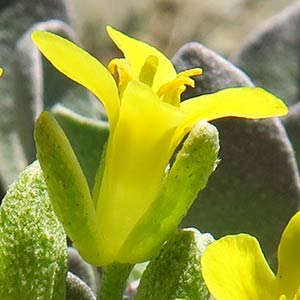|
alpine twin-pod, Washington bladder-pod, Washington twin-pod
|
double bladderpod, pointleaf twinpod, Rydberg's twinpod, sharpleaf twinpod
|
| Perennials; caudex usually simple, rarely branched, (cespitose); (silvery) pubescent throughout, trichomes several-rayed, rays (1- or) 2-bifurcate, (low-umbonate, tubercles relatively few, small). |
Perennials; caudex branched, (sometimes forming a thick crown, cespitose); (silvery) pubescent throughout, trichomes several-rayed, rays furcate, (moderately tuberculate, rays weakly so). |
several from base, decumbent to ascending, (unbranched), 0.5–1.5 dm. |
several from base, usually somewhat decumbent, (unbranched), (0.4–)0.5–2 dm. |
(petiole slender); blade obovate, 3–5 cm (width 10–20 mm, base tapering abruptly to petiole), margins entire, (apex rarely slightly acute). |
(petiole slender, often narrowly winged); blade obovate to orbicular or rhombic-orbicular, 2–9 cm, (base abruptly narrowed to petiole), margins usually entire, rarely with few scattered teeth, (apex rounded or obtuse, sometimes with apical mucro). |
blade oblanceolate, 0.5–1.5 cm (width 3–5 mm), margins entire. |
blade spatulate to oblanceolate, 1–3 cm, margins entire, (apex usually obtuse). |
subcorymbose. |
loose, (elongated in fruit). |
sepals oblong, 8–10 mm; petals spatulate, 12–14 mm. |
sepals linear-oblong, 4–7.5 mm; petals spatulate, 6–11 mm. |
(divaricate, straight), 5–10 mm. |
(divaricate, slightly sigmoid or nearly straight), 6–12 mm. |
didymous, mostly highly inflated (strongly flattened at least in 1/2 toward replum), 14–18 × 14–18 mm, (papery, basal sinus slightly notched, apical open, shallow); valves (retaining seeds after dehiscence), evenly pubescent; replum lanceolate, 7–10 mm, width 1.5–2.5 mm, as wide as or wider than fruit, apex acute to acuminate; ovules 8–10 per ovary; style 5–7 mm. |
(erect), didymous, suborbicular, inflated, (4–)6–15 × (4–)8–20 mm, (papery, basal and apical sinuses similar, basal rarely shallower, apical deep, narrow and closed or nearly so); valves retaining seeds after dehiscence, pubescent, trichomes appressed; replum oblong, constricted, 2–3.5 mm, narrower than fruit, apex obtuse; ovules (2 or) 4 per ovary; style 4–6(–9) mm. |
flattened, (2–3 mm). |
(dark brown), flattened, (2–3 mm). |
= 48–52, 52, 64, 67–70. |
= 10, 16, 24. |
|
|
|
|
| Flowering May–Jun. |
Flowering May–Jun(-Jul). |
| Alpine scree, rocky ridges, talus slopes, volcanic sands and gravel, serpentine gravel, granitic slopes, mountain shrub, subalpine fir, and whitebark pine communities |
Hillsides, roadcuts, sagebrush, pinyon-juniper, Gambel oak, ponderosa pine communities |
| (700-)1300-2400 m ((2300-)4300-7900 ft) |
1500-3500 m (4900-11500 ft) |
|
WA
|
AZ; CO; ID; MT; NM; NV; SD; UT; WY
|
|
Physaria acutifolia tends to be somewhat dwarfed, with a branched caudex and especially long styles (var. stylosa), where it grows at high elevations, especially at the western end of the Uinta Mountains in Utah. Intermediates form an uninterrupted cline and no infraspecific taxa are here recognized. In R. C. Rollins (1939), the discussion of P. acutifolia actually pertains to P. rollinsii. The discussion of P. australis pertains to what is now known as P. acutifolia. The plants are usually found in open soil patches, rarely into the subalpine or alpine tundra. (Discussion copyrighted by Flora of North America; reprinted with permission.) |
| FNA vol. 7, p. 624. |
FNA vol. 7, p. 624. |
| Brassicaceae > tribe Physarieae > Physaria |
Brassicaceae > tribe Physarieae > Physaria |
P. acutifolia, P. alpina, P. angustifolia, P. arctica, P. arenosa, P. argyraea, P. arizonica, P. aurea, P. bellii, P. brassicoides, P. calcicola, P. calderi, P. carinata, P. chambersii, P. cinerea, P. condensata, P. congesta, P. cordiformis, P. curvipes, P. densiflora, P. didymocarpa, P. dornii, P. douglasii, P. eburniflora, P. engelmannii, P. eriocarpa, P. fendleri, P. filiformis, P. floribunda, P. fremontii, P. garrettii, P. geyeri, P. globosa, P. gooddingii, P. gordonii, P. gracilis, P. grahamii, P. hemiphysaria, P. hitchcockii, P. humilis, P. integrifolia, P. intermedia, P. kingii, P. klausii, P. lata, P. lepidota, P. lesicii, P. lindheimeri, P. ludoviciana, P. macrocarpa, P. mcvaughiana, P. montana, P. multiceps, P. navajoensis, P. nelsonii, P. newberryi, P. obcordata, P. obdeltata, P. occidentalis, P. oregona, P. ovalifolia, P. pachyphylla, P. pallida, P. parviflora, P. parvula, P. pendula, P. pinetorum, P. prostrata, P. pruinosa, P. pulvinata, P. purpurea, P. pycnantha, P. rectipes, P. recurvata, P. reediana, P. rollinsii, P. saximontana, P. scrotiformis, P. sessilis, P. spatulata, P. subumbellata, P. tenella, P. thamnophila, P. tumulosa, P. valida, P. vicina, P. vitulifera |
P. alpestris, P. alpina, P. angustifolia, P. arctica, P. arenosa, P. argyraea, P. arizonica, P. aurea, P. bellii, P. brassicoides, P. calcicola, P. calderi, P. carinata, P. chambersii, P. cinerea, P. condensata, P. congesta, P. cordiformis, P. curvipes, P. densiflora, P. didymocarpa, P. dornii, P. douglasii, P. eburniflora, P. engelmannii, P. eriocarpa, P. fendleri, P. filiformis, P. floribunda, P. fremontii, P. garrettii, P. geyeri, P. globosa, P. gooddingii, P. gordonii, P. gracilis, P. grahamii, P. hemiphysaria, P. hitchcockii, P. humilis, P. integrifolia, P. intermedia, P. kingii, P. klausii, P. lata, P. lepidota, P. lesicii, P. lindheimeri, P. ludoviciana, P. macrocarpa, P. mcvaughiana, P. montana, P. multiceps, P. navajoensis, P. nelsonii, P. newberryi, P. obcordata, P. obdeltata, P. occidentalis, P. oregona, P. ovalifolia, P. pachyphylla, P. pallida, P. parviflora, P. parvula, P. pendula, P. pinetorum, P. prostrata, P. pruinosa, P. pulvinata, P. purpurea, P. pycnantha, P. rectipes, P. recurvata, P. reediana, P. rollinsii, P. saximontana, P. scrotiformis, P. sessilis, P. spatulata, P. subumbellata, P. tenella, P. thamnophila, P. tumulosa, P. valida, P. vicina, P. vitulifera |
| Lesquerella alpestris |
P. acutifolia var. stylosa, P. australis, P. didymocarpa var. australis, P. stylosa |
| Suksdorf: W. Amer. Sci. 15: 58. (1906) |
Rydberg: Bull. Torrey Bot. Club 28: 279. (1901) |
| |


